I was positively bursting with pride as I watched my oldest son present his first ever project at his school’s learning fair.

I’m always looking for ways to supplement his education at home, and when I discovered that the learning fair was open to kindergarten students, I thought it would be a perfect opportunity to learn together and practice some important life skills.
My son’s interests are all over the map. His immediate response was that he wanted to do a painting. That would have been fine, but I wanted something that would take more than an hour at the dining room table, and that would involve some research.
He had been enjoying watching ocean documentaries with his dad, and it finally occurred to me that we could combine his interest in art with his interest in sea creatures to produce a lengthier project from which he would learn. He was immediately excited about the idea.
Months before the project fair, I filled in the registration form declaring that my son would research sea creatures and then draw them himself. It sounded a little ambitious at the time, and turned out to be more ambitious than it sounded, but he did it.
Completing a lengthy project together taught us both important things.
1. Working with a budget
I was happy to read in the project fair rules that we were to aim to spend no more than $5, and no commercial kits were allowed. This really encourages resourcefulness and imagination on the part of the kids, and the variety of projects we saw in the school gymnasium reflected this.

In our case, we were able to take advantage of a store closing sale to pick up some of the basics we needed, like a cardboard backdrop, some paints and paintbrushes. I also grabbed a bag of seashells, but in hindsight I wish I hadn’t; the first words out of everyone’s mouth were “Where did you find all of those shells?” To which my brutally honest five-year-old happily responded “My mommy bought them at the store!”
Other than the store bought shells, we relied on basic art supplies and creativity — my son drew his ocean creatures on card stock and colored them in with crayon and marker. We also realized that we could repurpose some pressed cardboard fillers from a box to make a perfect coral reef. The colorful menagerie was a sight to behold.
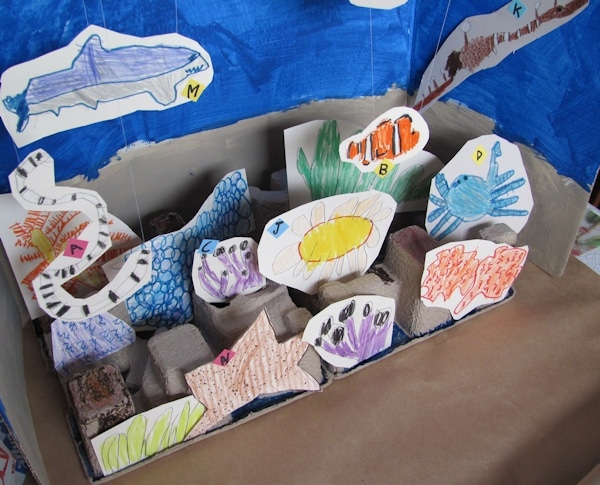
2. Using the public library
Since school has started, we haven’t visited the public library as much as we used to. This project was a perfect opportunity to reintroduce my son to this great resource, and to explore the “big kids” section instead of the playful reading area where he spent time as a toddler.
We looked at the labels on the walls to find the proper section, and then found a whole treasure trove of ocean-related books. My son brought his big pile of books to the desk to check them out himself.
He also made a new friend while he was there; another boy approached him to play an impromptu game of chess! The library is good for lots of things.
3. Research skills
My son chose the animals that interested him, and we made a list. We searched on the internet and in his library books for information. He learned how to choose a few important or interesting facts from a larger passage, and restate them in his own, simpler words.
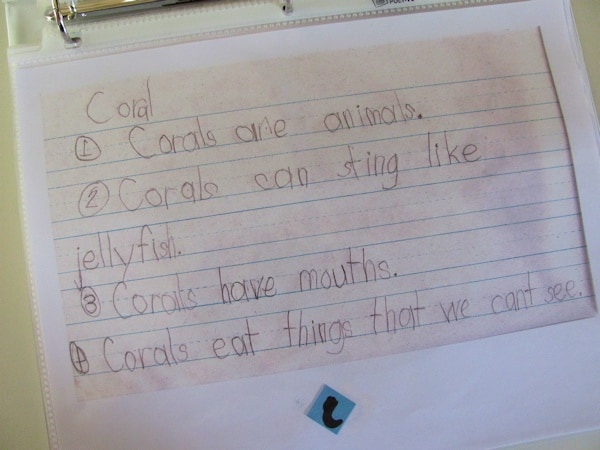
For each animal, he produced a page of numbered notes summarizing the facts that he wanted to share, and we later decided to turn his notes into a book to present along with his project. I helped him make a bibliography page to share the books that helped him with his project, so others would know where he learned his information, and could read the books themselves if they wanted to.
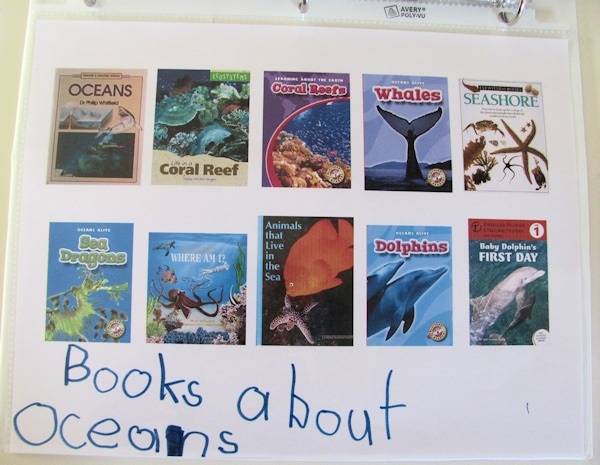
I remembered the research skills I learned at a much older age, and simplified them. I thought it would be a great way to introduce my son to proper research skills in a way that made sense to him.
4. Persistence
After he had completed his project, I asked my son what he had learned. I was surprised when the first words out of his mouth were “Never, ever give up!” Indeed. We learned that by breaking a big job into smaller pieces and steadily working a little at a time, it would all come together into something great. Even a kindergarten kid with his sometimes brief attention span could produce a big presentation.
Drawing the individual sea creatures taught persistence, too. Sometimes my son’s sketch just didn’t look even remotely like the picture in the book. He’d have to erase and try again until he was satisfied. I’ve seen him want to give up on many endeavors, but I guess knowing in his mind what he wanted his project to look like kept him forging ahead toward his goal.
It was good practice for me, too. More than once, as I sat at the dining room table watching my son spend forever drawing one sea creature, I thought “What have I gotten myself into?” In my own endeavors, I tend to like to accomplish big things all in one go, not a little at a time. I needed the reminder that a slow, steady pace can lead to great results.
5. Asking for help
There were a few animals that just couldn’t seem to make the transition from book page to paper no matter how hard my son tried to mimic their shapes. The starfish, though seemingly simple, presented a particular challenge. “Mommy, can you show me how to draw a star?” my frustrated son asked.
I sketched a star shape as I talked him through the steps, showing how multiple “triangles” connected to one another. After that he was able to replicate a star himself. Well, it wasn’t perfect, but it could pass for a starfish, and he was pleased to have finally tackled the task.
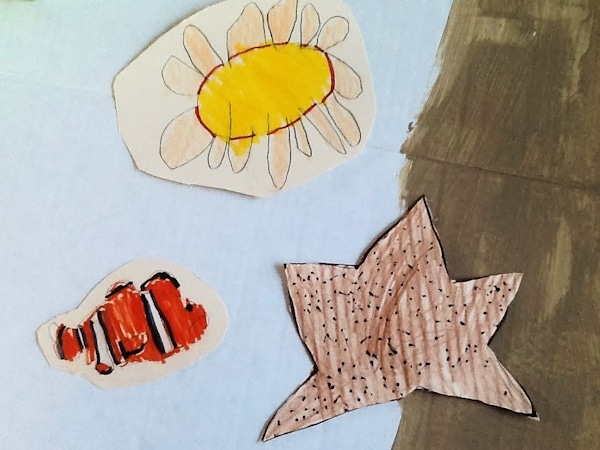
I was reminded of piano lessons when I was a little older than my son is. I knew how to read the notes, I knew where the keys were on the piano, but sometimes the melody just didn’t come out right. One day my teacher offered to play it herself first so I could hear and see how the notes flowed together. It worked, and from then on asking for an example was an option I took advantage of whenever I was stuck.
Sometimes we all need to ask for help or advice in order to get out of a rut.
6. Knowing your limits
I thought a map of the ocean would make a great book cover, so I gave my son a sheet of paper, his kid’s atlas, and told him to draw one. Yes, draw one. My son is very interested in maps and has doodled his own versions of the globe before, so I didn’t think I was completely off my rocker. I knew it wouldn’t look very real, but I thought it would be cute.
However, after several minutes, there were various blobs taking over the paper and with three continents drawn, there was scarcely room for the rest of the land, never mind the vast expanses of water that are supposed to make up more than 70% of the globe. Plus, I noticed my son was getting discouraged; he knew this wasn’t working.
I admitted that I had asked him to do a really tough job, and although he had tried his best and had done great, we would probably be better off using a coloring sheet instead. He was relieved. We found a blank map of the earth online, and my son had fun coloring it in to match his world atlas example, then labeled the oceans himself.

There are some things that we should “try, try again”, but sometimes it’s perfectly okay to admit when something is beyond our scope of ability.
7. Letting go of perfectionism
I am a big-time perfectionist. Sometimes it’s advantageous, but a lot of times perfectionism is inhibiting. I don’t want my kids to feel paralyzed by their own expectations for themselves the way I have been at times.
One night we got into a little spat when my son wanted to erase and re-draw his pelican’s beak for the fifth time, and I wouldn’t let him. It had looked great, and every time he tried to perfect the shape of the pouch, it looked less pelican-like. Moreover, we were nearing the deadline and there was still more work to get done; he had to learn to move on in order to finish what he had started.
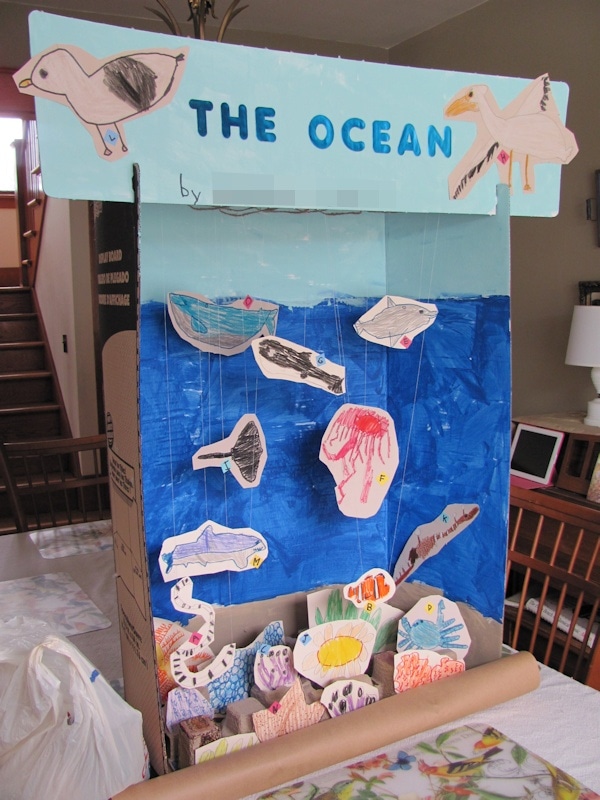
I remembered a middle school art teacher who once told me that sometimes a good artist needs someone to tell her to “STOP!” A great work of art could be ruined by adding “just one more thing”, or trying to fix something that wasn’t really a problem to begin with.
For my own part, I had to remind myself that a five-year-old was making this project, and I wanted the project to reflect that more than the perfect image I had in my mind. So, I didn’t pick up the scissors to fix the jagged cut-out edges on the fish, and I didn’t correct spelling errors like “mammls” or “dringk” (though he had to re-do backwards letters and words that he should already know).
In the end, my son’s project exceeded my wildest expectations. Sure, there were misspellings, and maybe not all of the animals were easily identifiable on their own, but it was a beautiful testament to a five-year-old boy’s determination, interest, and hard work.
8. Togetherness
By the end of the day I’m pretty much sapped of energy, but my boys, well, aren’t. Having a project to work on together was a great low-key way to spend meaningful time together. “Mommy, do you want to look up see creatures?” became a familiar request after dinner.
We’d huddle together watching see creature videos, or reading sea creature books, and it didn’t require a lot from me. In fact, we both found it interesting. Sea dragons? Who knew they existed? Helping my son with his project turned out to be a great way to force myself to slow down, unwind and spend time with him, all while working toward our goal.
9. Self confidence
My son is already a lot less timid than I was as a kid, but he’s not naturally very outgoing, either. Making a formal presentation in front of an audience wasn’t part of the deal, but we talked about how he would need to be ready to explain his project to visitors and answer questions.
“Even if it’s a stranger?” my son asked. I explained that the only reason people would come to the project fair would be to learn, and he could consider everyone, young and old, his friend. At home he practiced pointing to fish and saying their names. I asked a variety of serious and silly questions. By the time project fair night arrived, he was very excited to share his work.
He wasn’t required to stand by his project the whole time, but he was eager to talk to people who showed an interest. I stayed back and watched proudly from a distance as he shared his work with kids and adults.
There’s no reason to feel intimidated by people we don’t know, especially when we share a common interest. The more we practice, the easier it becomes to connect with others.
10. Possibility
My son has spent the past several years completely dedicated to the idea of being a road worker when he grows up. In fact, if you mentioned any other possibility to him, he would get a little upset. He can be whatever he wants as far as I’m concerned, and I had fun observing his passion for road work.
But one evening a documentary about Cocos Island proved to be a game changer. My son and I watched as scientists loaded themselves into a small submarine and observed ocean life from its large globe-like window.
“That’s what I’m going to do someday,” he said.
Now, he is going to be a scientist. I won’t be able to visit him at his house someday, because he will be traveling all the time. He needs to explore the oceans, and he needs to see what kinds of animals live in the desert, but first on his agenda is traveling to space to find out if aliens are real.
Actually, having completed his first research project, he will tell you that he already is a scientist. And I agree.


Great job working with the kid. He will probably remember that for the rest of his life.
Thank you! I never really thought about that, but it would be nice if this is a happy memory for him years from now.
The sort of supportive but non-controlling involvement you describe promotes success in school and life. As a former teacher, I know how powerful involved parents can be. Great post.
Thank you! I try to be exactly the kind of parent you describe. I want my boys to get the best start I can give them.